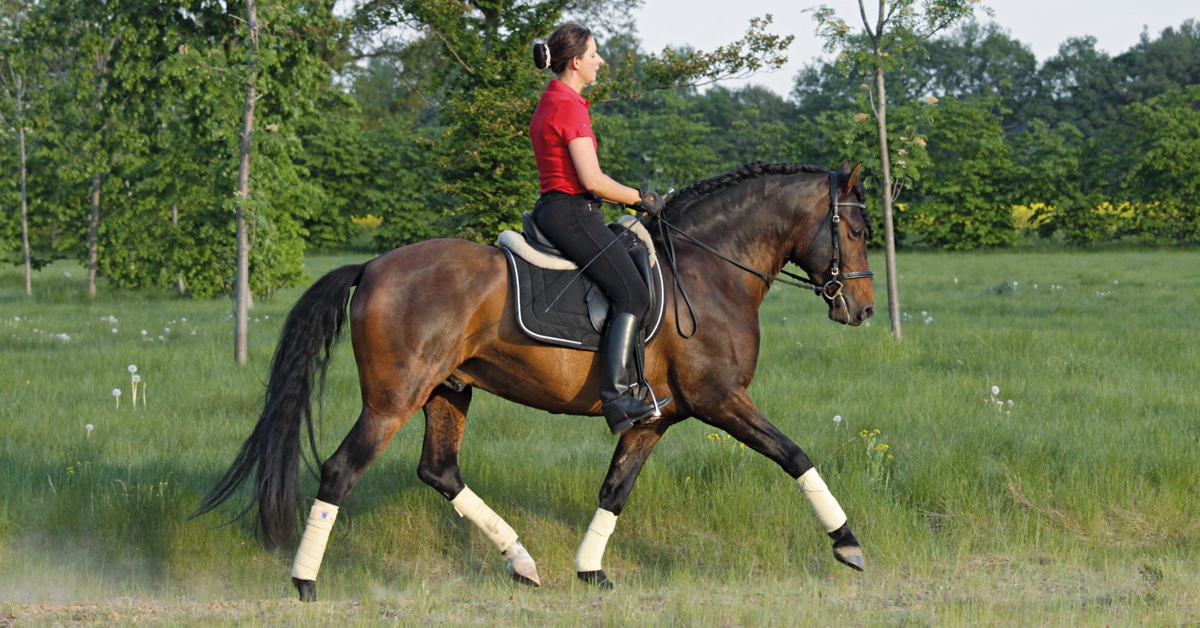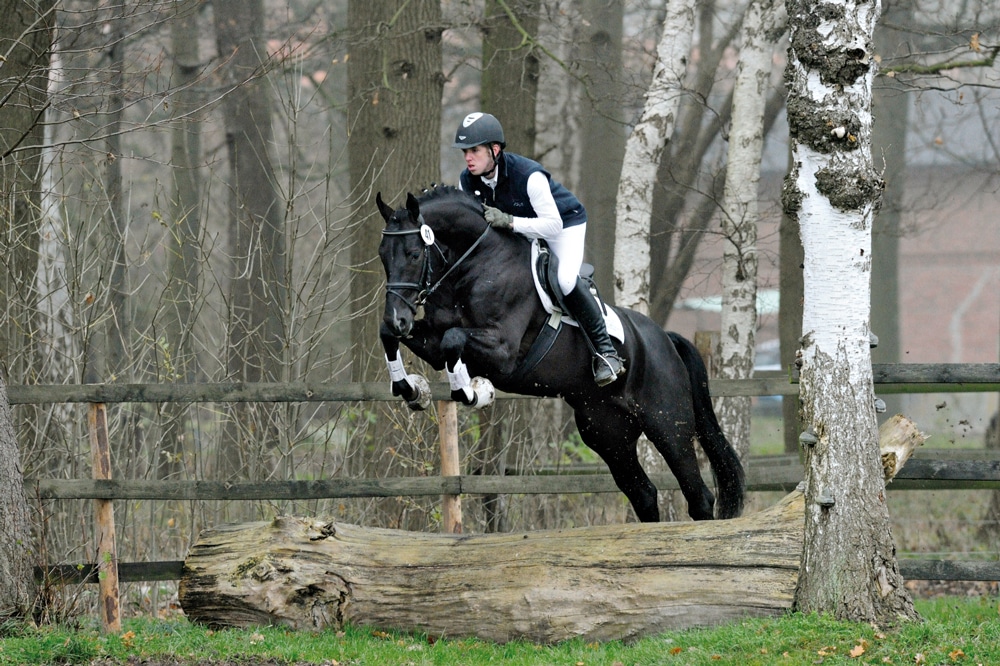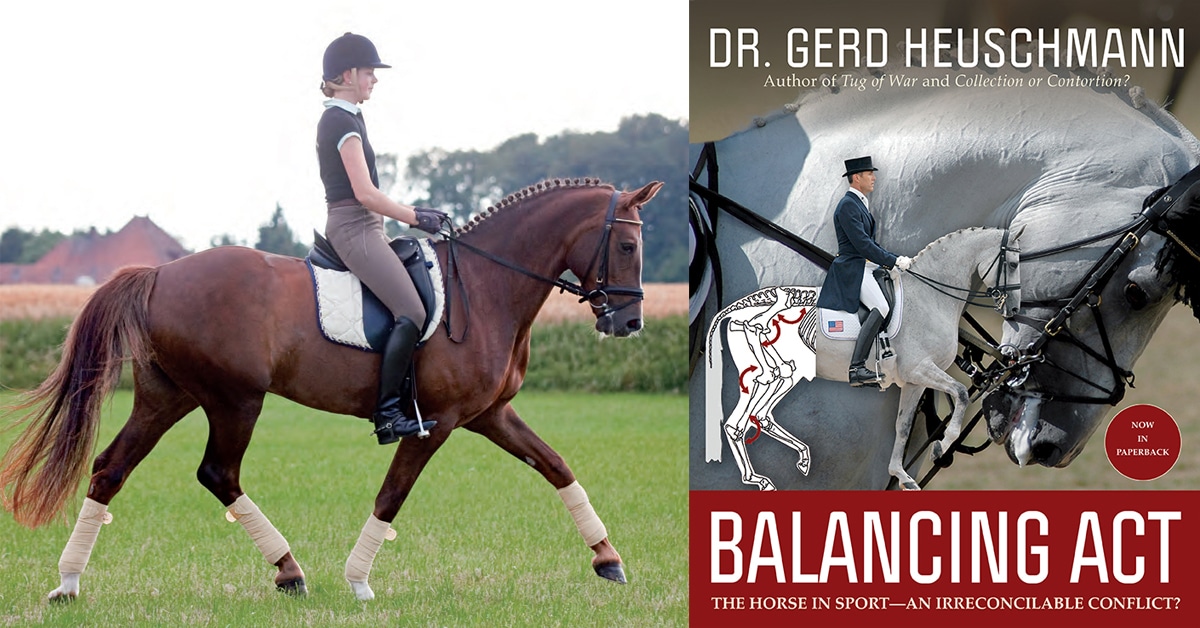THE QUALITY OF CONTACT
The horse has learned to step to the tactful hand with a relaxed trunk, in a secure basic rhythm, with a supple neck. He carries his head and neck in a natural position so that the poll is the highest point, even for a young horse. The correct head position, with the nose in front of the vertical, follows. This requirement of Classical Riding theory cannot be repeated too often. Only in this carriage can true contact develop. On this subject, I would like to present a passage by Waldemar Seunig that makes it clear that harmony is about the quality of the contact:
“To this end, the horse must put himself in the hand with a relaxed poll at the highest point, and an extended neck. A more secure contact results from the driving aids. This indicates, incidentally, that longitudinal flexion, which always has a ‘flavor’ of active hands about it, can be replaced to advantage.”
Waldemar Seunig, Von der Koppel bis zur Kapriole [From paddock to capriole], Olms Press, Hildesheim, Zürich, New York, 2001, p. 132

The swinging of the back, which leads to suppleness, was described for the first time in 1896 by Bernhard Hugo von Holleuffer.
The horse can maintain a secure rhythm without running away or getting lazy. Rhythm depends on the supple seat of the rider—a rider can sit in the saddle with such feeling and suppleness that the horse builds only the slightest defensive tension in his back. And, very importantly, the rider can begin using an appropriately driving seat. “Driving” requires that the horse accepts encouragement to go forward, which he must learn to do. A continually braced back is the wrong way to encourage the horse to move freely forward. (see Wilhelm Müseler, Riding Logic, Trafalgar Square Books, North Pomfret, Vermont, 2007, p. 32).
Von Holleuffer relates contact to the swinging of the back, explaining that contact arises from the swinging. Moving with a secure rhythm causes the back to swing and encourages the horse to seek an even contact with the rider. In this way, the horse has again found his natural, basic balance.
This reestablished natural balance is the rider’s work platform. From this point, the stretching ability of the horse can be developed in order to later achieve relative elevation in correct collection.
The sentence “a young horse must be ridden forward and downward” is correct to a certain point. You need stretching, but before that you need natural balance. Without balance, there is no correct stretching. The next step is to develop the stretching ability of the horse. This is accomplished effectively by “letting the reins be ‘chewed’ out of the hands” as the horse seeks to stretch his neck further. These exercises can dramatically improve the suppleness, strength and mobility of the long back musculature.
UNDERSTANDING FORWARD
As the ability to stretch improves while in natural balance, an important platform is created for the next components in the Training Scale: Impulsion and Straightness. The training plan is founded on three elements:
QUIET
FORWARD
STRAIGHT
A trainer friend, Andrea Jänisch, once suggested to me that the famous saying by Gustav Steinbrecht, “Ride your horse forward and make him straight” should be changed, since forward riding is often misunderstood as going fast. She suggested: “Ride your horse forward—as well as slowly—and make him straight!” A wonderful sentence! It hits the nail on the head.
Peter Kreinberg explained the adverse effects of “chasing” the horse with your seat. He has his students walk in front of him on foot at a normal speed, walks behind them and regularly shoves them forward. Ask yourself how this constant shoving would affect your balance and your physical suppleness, particularly while someone was forcing your head down at the same time.
An even temperament and physical suppleness are especially important equestrian attributes. A good seat with appropriate stirrup length is a critical part of this. A cowboy friend from Montana said:
“Wait for your horse!” — Roland Moore
“Wait for your horse.” This sentence has been one of the most significant for me; in it lies the recognition that every action by the rider causes tension in the horse’s back. The harmony for which we strive requires a quiet and waiting posture that is also alert and active with sensitive, driving aids.

Especially in basic training, regular forward riding out on the trails and fields is an almost essential component. Natural obstacles encourage the attention and agility of the horse.
The better command a rider has of her art, the less she works physically.
Everything good comes from a quietly waiting, effectively tense but supple seat! Alertness and the rider’s wish to ride forward have nothing to do with pushing and squeezing. Correct forward riding is more about body posture and attitude than nonstop “forward nitpicking!”
The measure and importance of the effect of the seat are determined by the level of training and the anatomy of the horse. A supple seat gradually takes over more of the driving aids. This has absolutely nothing to do with commands such as “Sit down; legs on; more leg!” The driving effect of the leg and seat should not stem from tension in the rider or from force or power. Forward riding has nothing to do with strength and squeezing legs or a continually tense rider’s back.
WAIT AND FIND THE RHYTHM
Roland Moore’s advice, “Wait for your horse!” wonderfully describes sensitivity in the body that leads to finding the rhythm of every individual horse. As a result of the rider feeling quiet and calm, the horse begins to wait. Then the rider begins—very carefully at the beginning—driving from her supple seat. It is sensible to creep up carefully with the driving aids for both the young horse and a horse in retraining.
In Volume 1 of Richtlinien für Reiten und Fahren: Grundausbildung für Reiter und Pferd [Guidelines for riding and driving: basic training for horse and rider], rhythm is defined as the “spatial and temporal exactness of movements” (FN Verlag, Warendorf 1997, 28th edition). A further, very important criterion is finding the right tempo. Either a rushing or “low-revs” horse can also move in spatial and temporal precision. However, when he isn’t moving at the tempo that matches him, the horse won’t find his rhythm. If a horse goes above or below his individual tempo (most horses rush and go far above the appropriate tempo), he can neither relax nor find horizontal balance. I like to compare rhythm with the pendulum of a mechanical clock. In order to find the rhythm of a horse, the rider must find the horse’s own frequency and bring him to swinging movements.
Swing together in rhythm
A key for further training lies in finding the individual rhythm for each horse; finding this rhythm lays the first foundation stone for harmony. B. H. v. Holleuffer speaks of “swinging,” a motion that needs to be developed. The horse can only begin to swing when moving in his own individual rhythm. Swinging is the expression of rhythmical movement with the first steps of suppleness.
A comparison with an adept dance couple comes to mind. Harmony lies in finding rhythm, which allows the dancers to relax and the dance to become enjoyable. If the lead dance partner suddenly quickens the tempo and starts a completely different rhythm from mine and the music, I would tighten up considerably and not have a feeling of harmony. Allowing yourself to “fall,” in suppleness assumes that rhythm has been achieved. Similarly, only in the rhythm is it possible to find suppleness in both horse and rider. When this occurs, the feeling is good and the rider is balanced and supple. The horse begins to swing in reaction to the rider’s supple seat that swings with his back.
Rhythm, Suppleness, and Contact are the foundation. Everyone knows that you cannot build a house without a stable foundation!
SUPPLENESS
Suppleness or “looseness” refers to an inner calm, supplely working muscles and a lack of force. It is necessary for the horse to accept the leg (the driving aids) without running away or having to be asked for every step. When this state is achieved, the horse waits for the rider and willingly allows himself to be “driven” to contact from a supple seat. Suppleness describes a state where a horse is active without negative tension. A supple horse is ready and willing to work, not lazy hectic, spooky, nervous, rushing or running away.
The real task of the first three points of the Training Scale is preparing a horse to be able to move in balance. The criteria of Rhythm, Suppleness and Contact are non-negotiable! A horse can only develop to his best when you allow him enough time for his physical and mental development. When this correct foundational work isn’t done early, it will need to be done later in the horse’s retraining. A hasty training schedule that concentrates on mechanical work (exercises) always leads to problems.
***
Balancing Act: The Horse in Sport—An Irreconcilable Conflict?, by Dr. Gerd Heuschmann, published by Trafalgar Square Books, is available here.

